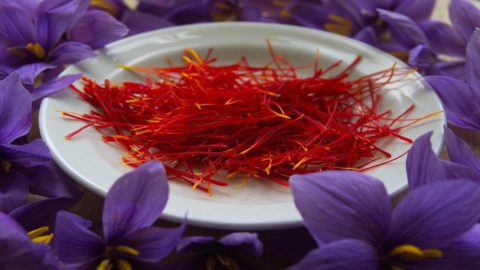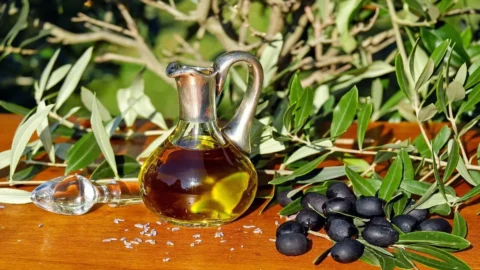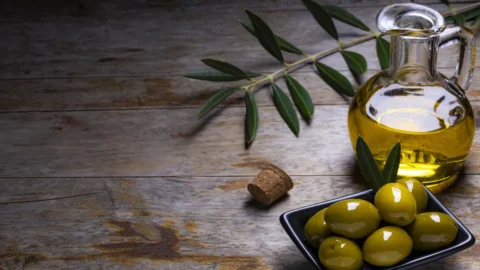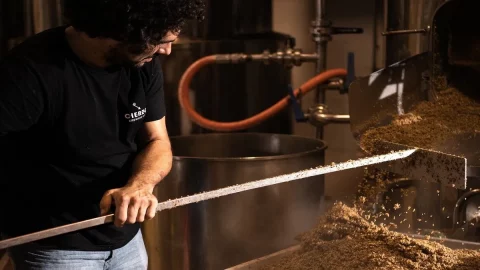The production of Tuscan saffron is increasingly tinged with pink. By now 80% of the farms that cultivate this precious spice are mainly made up of women, due to the patience and delicate dexterity required to collect the stigmas from the flower. Among the protagonists we find the young Carolina Calonaci, who has decided to abandon the world of fashion to devote himself to the cultivation of Made in Italy saffron.
In her early thirties, Carolina has a degree in Agriculture and a small land of about eight hectares, four of which are woodland, on the slopes of the Apennines, in the heart of Mugello. Carolina's love for the land and passion have allowed her to create a company almost from scratch where fields meet wild landscapes.
In its Podere Rio II, the farm promoted by Coldiretti "Fondazione Campagna Amica", has chosen a niche cultivation, capable of optimizing the little land available, with one and a half hectograms of organic pistils obtained from the flowering of 10 Crocus sativus flowers. However, the company offers a wide range of natural products, such as vegetables and fruit, medicinal herbs, honey and wine, which can be purchased in the premises of the barn, recently renovated into a laboratory, kitchen and sales point.
Currently the company has about 5000 meters for the production of this increasingly requested spice, thanks to its first-class quality, the Podere is part of the main producers' associations in Italy: "Italian Saffron Association"and "Association of the saffron of the Florentine hills".
The road was all uphill, with a beginning made of sacrifices and hard work. But today, the young Tuscan entrepreneur has managed to expand her business, among the farm and the agri-restaurant. There are dogs, horses, cats, peacocks, rabbits, chickens, ducks and the Vietnamese pig “Peppa Pig” to welcome visitors.
The agri-restaurant is open all year round but only by reservation and with an agreed fixed menu: from the traditional dishes of the Mugello area to the innovative ones based on saffron and truffles. There are also tastings to taste the real and genuine flavors of the countryside.
In short, a splendid atmosphere and place to visit with a bicycle and admire the efforts of a young Tuscan come true. But what differentiates it from other agricultural entrepreneurs is precisely the production of a precious product, such as saffron, also known as "red gold".
The cultivation of saffron is so ancient that the origin is the result of several legends: both Homer and Virgil and Pliny mention it in their works, both as an ingredient for cooking and as a dye for fabrics. In Ovid's "metamorphosis" it is said that the young Croco was in love with a nymph, but unrequited. The gods then decided to transform it into a plant, the Crocus Sativus to be precise.
In Roman mythology, on the other hand, it is said that the God Mercury, protector of trade and earnings, missed the throw of the discus, killing his friend Crocus. The blood came to dye the flower of the plant, so as to remain imprinted in the memory of men.
This spice was used a lot especially as dye for the most precious fabrics: from the Assyrians to the king of Ireland, up to the Egyptians who dyed the bandages with which they wrapped the mummies. A spice, already very expensive at the time, which only the richest families could afford. But it was also used as a natural cosmetic, for example it is said that Cleopatra used it to give a beautiful golden color to her skin.
Although the legends around this spice are different, it is believed that it was native to Asia Minor. The trade of him, then, spread all over the world. However, during the years of the end of the Roman Empire and the barbarian invasions, the cultivation of saffron in Europe came to a sudden stop and was lost. Only during the Arab invasion in the tenth century in Spain was it reintroduced, where it immediately aroused great interest.
The Hispanic people immediately understood the value of this product, so much so that they prevented the export of the bulbs by instituting very strict laws: from imprisonment to the death sentence. It was thanks to Father Cantucci, inquisitor at the time of Philip II, that saffron was introduced in Italy, where it is still grown with great success today.
With the discovery of America, saffron underwent a sharp decline due to the attention to the new vegetable spices typical of the new continent, including vanilla, chocolate and coffee. Only in certain areas of France, Italy but above all Spain, was he able to resist.
To date, the world production of saffron has about 178 tons per year, with Iran as the largest producer (90%), followed by India, Greece, Morocco, Spain and Italy (for the remaining 10%). In Italy its interest is always greater, strongly connected to the climatic trend, a production can be estimated between 450 and 600 kg, occupying approximately 50/55 hectares and 320 agricultural enterprises.
The regions most affected are Sardinia, Abruzzo, Tuscany, Umbria and the Marches, although small realities are also emerging in Sicily, Valtellina, Puglia, Cinque Terre and Tuscia. For the quality of the saffron, both that of Navelli and Sardinia have obtained the coveted DOP recognition, the cultivation of which was already in use since ancient times.
As far as the importation of this spice is concerned, according to Istat data, between unminced or pulverized and minced product, it is equal to over 22 kg for 2.937.838 euros. Instead, the export has an economic value estimated at over 551 thousand euros.
With an unmistakable colour, saffron is rich in nutrients that make it unique. Rich in mineral salts (phosphorus, potassium and magnesium), vitamins and folate. Among the vitamins the most abundant are A, C, and B which help the metabolism and the exchange of oxygen between cells. The saffron, on the other hand, is an essential oil that gives it an acrid and intense smell.
As for the yellow color of saffron it is due to the high amount of carotenoids contained in it, which serve to protect the cells by acting as anti-tumor agents. The bitter taste is given by pyrocrocin.
Saffron is one of the natural antioxidants par excellence, able to protect the body from aging and increase the immune system. Also famous for its properties digestive and dietetic, this spice is able to accelerate our metabolism due to the presence of vitamin B, which is able to stimulate the consumption of fats.
Furthermore, he also owns properties anti-inflammatory, antidepressant, detoxifying and aphrodisiac. A few grams are enough to flavor dishes, its massive use could have controversial effects such as dizziness and torpor.
It is a totally natural product, grown without the use of fertilizers, pesticides or chemicals. Its processing is completely handmade, so as to make it your own quite high economic value.
Saffron is obtained by drying and roasting the stigmas of the Crocus Sativus flower. The flower is sterile, it does not make seeds, so its propagation is guaranteed by the bulb. Inside the flower there are 3 red stigmas and it is they that provide the precious spice.
Harvesting begins with flowering and is done manually, before the full opening of the flowers (therefore at dawn), so as to keep the properties of the spice unchanged. Once the flowers have been collected, they are stored in baskets to let them air and, subsequently, subjected as soon as possible to moulding, or rather to the export of the stigmas.
The operation is very delicate, which is why it must necessarily be done by hand. To obtain a single gram it is necessary to clean from 100 to 150 flowers, in a limited amount of time (as the flowering period lasts approximately 6 weeks).
But it doesn't end there. After harvesting, you have to proceed with the drying of the stigmas. Different methods can be used, such as placing them in sieves over heat sources (embers, ovens, wood-burning fireplaces), or using dryers, or simply the sun (in some eastern Mediterranean countries the sun is very strong). In all cases the heat source must be moderate and not exceed 45°C. A few minutes and wrong steps are enough to lose all the work of a year.
At this point the stigmas can be placed in hermetically sealed glass jars or reduced to powder in the practical sachets that we all know. However, it is possible to grow this incredible spice even in a vase, but the whole manufacturing process should not be underestimated.
Also, you have to be wary of low-priced saffron powder: they are mixed together with turmeric or cumin or other substances without any nutritional value. Make sure the powder is an even, deep red color and free from white specks.
Once the spice has been purchased, both in pistils and in powder, this can flavor every course, from appetizers to desserts, able to color, enhance and enrich every dish. But be careful, how the two formats are used varies: the powder can be added at the end of cooking without further procedures, while the pistils must first be left to infuse, for about 40 minutes, in very hot water.
In both cases, where possible, it is advisable to add saffron only at the end of cooking, otherwise the heat could disperse all its organoleptic properties.
Among the best combinations are rice, like the famous saffron risotto, with shellfish, seafood, stewed meats and delicate sauces. It can also be used to enrich pizza or bread dough, as well as to enhance pan-fried vegetables. Also excellent with pasta and cheese, but above all with desserts (for example to flavor biscuits, muffins and cakes). And it is thanks to its versatility that saffron is one of the most popular spices in Italian cuisine.





